Examination of the skin Skin The skin, also referred to as the integumentary system, is the largest organ of the body. The skin is primarily composed of the epidermis (outer layer) and dermis (deep layer). The epidermis is primarily composed of keratinocytes that undergo rapid turnover, while the dermis contains dense layers of connective tissue. Skin: Structure and Functions is a fundamental part of the standard physical exam. This exam consists of a thorough inspection of the skin Skin The skin, also referred to as the integumentary system, is the largest organ of the body. The skin is primarily composed of the epidermis (outer layer) and dermis (deep layer). The epidermis is primarily composed of keratinocytes that undergo rapid turnover, while the dermis contains dense layers of connective tissue. Skin: Structure and Functions of the entire body. The assessment focuses on identifying abnormal signs on the skin Skin The skin, also referred to as the integumentary system, is the largest organ of the body. The skin is primarily composed of the epidermis (outer layer) and dermis (deep layer). The epidermis is primarily composed of keratinocytes that undergo rapid turnover, while the dermis contains dense layers of connective tissue. Skin: Structure and Functions, such as the scalp, orifices, nails, and mucosal surfaces. Dermatologic findings can represent localized processes or may be a sign of systemic disease.
Last updated: Dec 15, 2025
Primary skin lesions Primary Skin Lesions The identification and classification of skin lesions in a patient are important steps in the diagnosis of any skin disorder. Primary lesions represent the initial presentation of the disease process. Primary Skin Lesions occur as a direct result of a pathologic process, while secondary skin lesions Secondary Skin Lesions The identification and classification of a patient’s skin lesions are important steps in the diagnosis of any skin disorder. Secondary lesions develop from irritated or manipulated primary lesions and/or manifestations of disease progression. Secondary Skin Lesions are those that result from manipulation of the skin Skin The skin, also referred to as the integumentary system, is the largest organ of the body. The skin is primarily composed of the epidermis (outer layer) and dermis (deep layer). The epidermis is primarily composed of keratinocytes that undergo rapid turnover, while the dermis contains dense layers of connective tissue. Skin: Structure and Functions.
| Primary skin Skin The skin, also referred to as the integumentary system, is the largest organ of the body. The skin is primarily composed of the epidermis (outer layer) and dermis (deep layer). The epidermis is primarily composed of keratinocytes that undergo rapid turnover, while the dermis contains dense layers of connective tissue. Skin: Structure and Functions lesion | Description |
|---|---|
| Macule Macule Nonpalpable lesion < 1 cm in diameter Generalized and Localized Rashes |
|
| Papule Papule Elevated lesion < 1 cm in diameter Generalized and Localized Rashes | Small palpable skin Skin The skin, also referred to as the integumentary system, is the largest organ of the body. The skin is primarily composed of the epidermis (outer layer) and dermis (deep layer). The epidermis is primarily composed of keratinocytes that undergo rapid turnover, while the dermis contains dense layers of connective tissue. Skin: Structure and Functions lesion ≤ 1 cm in diameter |
| Plaque Plaque Primary Skin Lesions | Palpable, raised lesion > 1 cm |
| Nodule Nodule Chalazion |
|
| Vesicle Vesicle Primary Skin Lesions | Small fluid-containing blister Blister Bullous Pemphigoid and Pemphigus Vulgaris ≤ 1 cm in diameter |
| Bullae Bullae Erythema Multiforme | Large fluid-containing blister Blister Bullous Pemphigoid and Pemphigus Vulgaris > 1 cm in diameter |
| Pustule Pustule Blister filled with pus Generalized and Localized Rashes | Vesicle Vesicle Primary Skin Lesions filled with pus |
| Secondary skin lesions Secondary Skin Lesions The identification and classification of a patient’s skin lesions are important steps in the diagnosis of any skin disorder. Secondary lesions develop from irritated or manipulated primary lesions and/or manifestations of disease progression. Secondary Skin Lesions | Description |
|---|---|
| Scale |
|
| Crust Crust Dried exudate of body fluids (blood, pus, or sebum) on an area of damaged skin Secondary Skin Lesions | Dried exudates, such as pus or blood |
| Fissure Fissure A crack or split that extends into the dermis Generalized and Localized Rashes |
|
| Ulcer |
|
| Erosion Erosion Partial-thickness loss of the epidermis Generalized and Localized Rashes |
|
| Necrosis Necrosis The death of cells in an organ or tissue due to disease, injury or failure of the blood supply. Ischemic Cell Damage | Dead skin Skin The skin, also referred to as the integumentary system, is the largest organ of the body. The skin is primarily composed of the epidermis (outer layer) and dermis (deep layer). The epidermis is primarily composed of keratinocytes that undergo rapid turnover, while the dermis contains dense layers of connective tissue. Skin: Structure and Functions tissue |
| Atrophy Atrophy Decrease in the size of a cell, tissue, organ, or multiple organs, associated with a variety of pathological conditions such as abnormal cellular changes, ischemia, malnutrition, or hormonal changes. Cellular Adaptation |
|
| Scar | Replacement of the skin Skin The skin, also referred to as the integumentary system, is the largest organ of the body. The skin is primarily composed of the epidermis (outer layer) and dermis (deep layer). The epidermis is primarily composed of keratinocytes that undergo rapid turnover, while the dermis contains dense layers of connective tissue. Skin: Structure and Functions with fibrotic and connective tissue Connective tissue Connective tissues originate from embryonic mesenchyme and are present throughout the body except inside the brain and spinal cord. The main function of connective tissues is to provide structural support to organs. Connective tissues consist of cells and an extracellular matrix. Connective Tissue: Histology as a result of destruction |
| Lichenification Lichenification Atopic Dermatitis (Eczema) |
|
All cutaneous and mucosal surfaces should be examined in good light. Wear gloves, especially if the skin Skin The skin, also referred to as the integumentary system, is the largest organ of the body. The skin is primarily composed of the epidermis (outer layer) and dermis (deep layer). The epidermis is primarily composed of keratinocytes that undergo rapid turnover, while the dermis contains dense layers of connective tissue. Skin: Structure and Functions is broken.
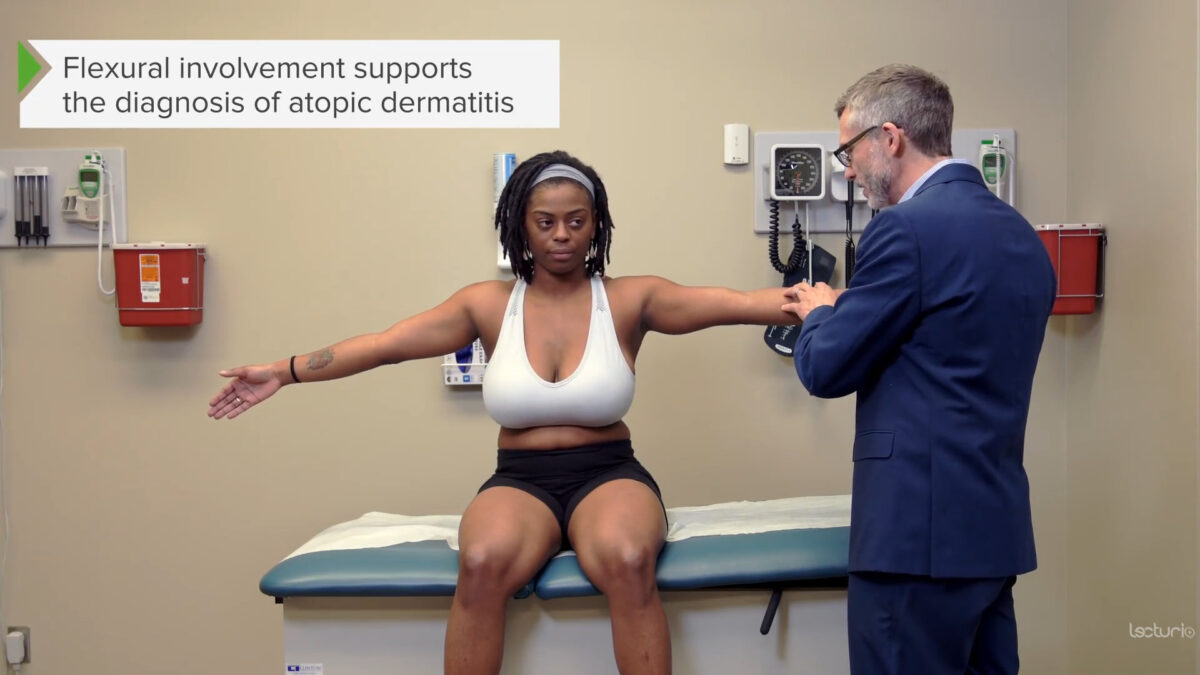
Examination of the flexor aspects of the arms (involvement of the flexural surfaces most commonly suggests atopic dermatitis)
Image by Lecturio.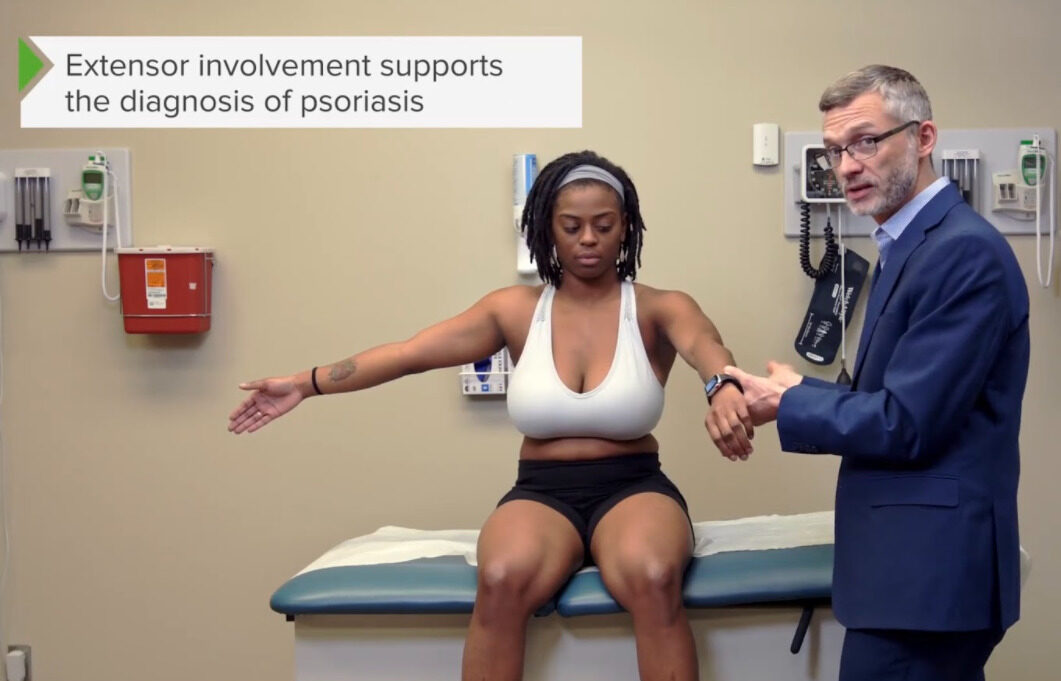
Examination of the extensor aspects of the arms (psoriasis typically involves the extensor surfaces)
Image by Lecturio.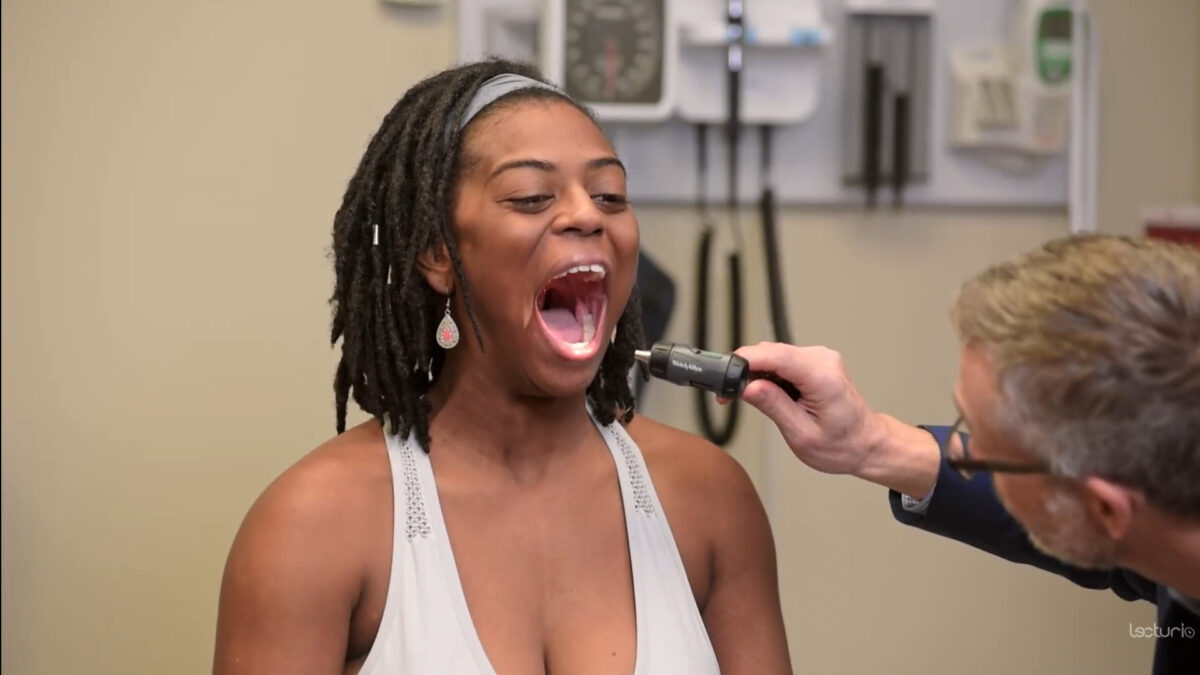
Examination of the mouth: buccal surface and palate
Image by Lecturio.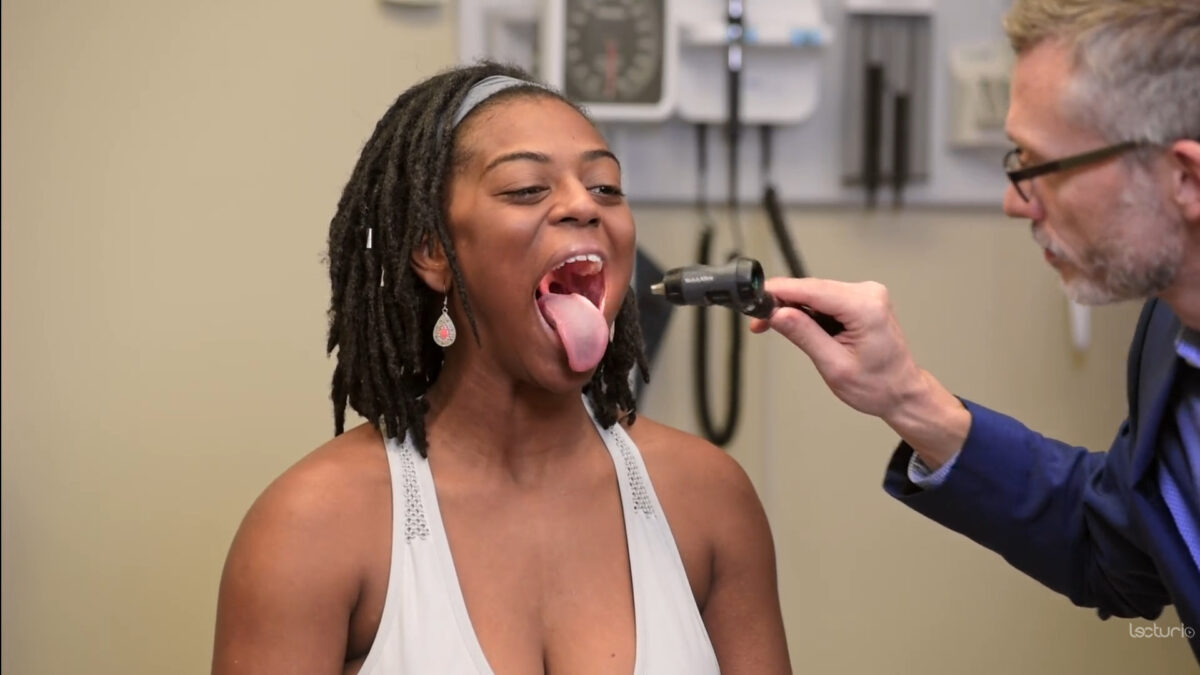
Examination of the tongue
Image by Lecturio.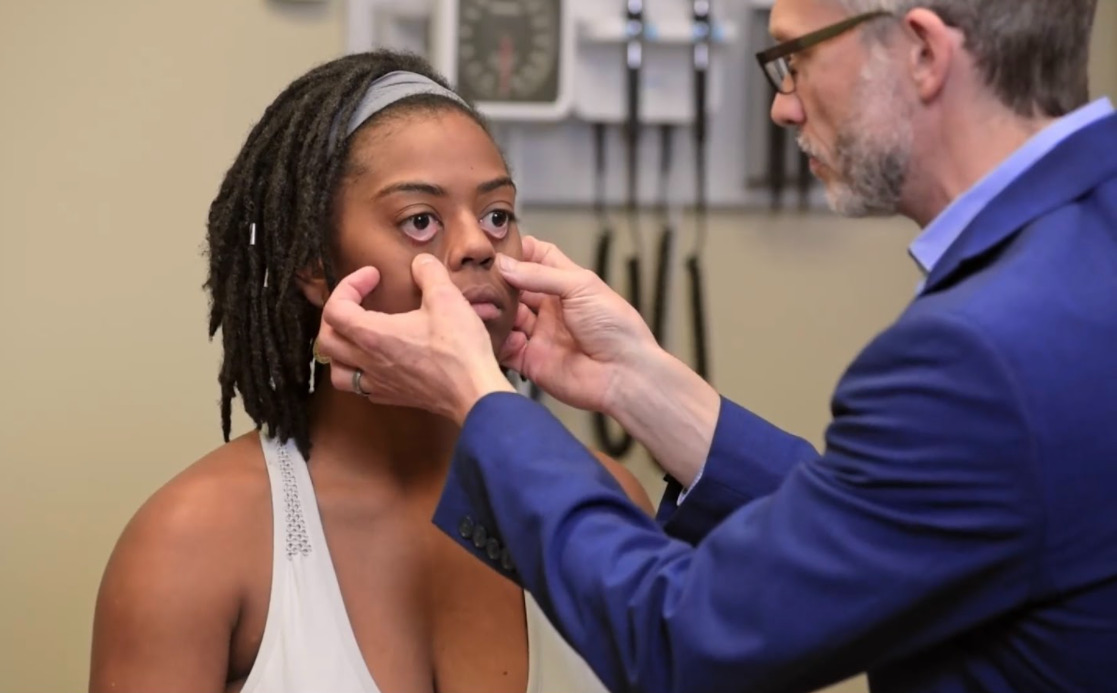
Examination of the conjunctiva
Image by Lecturio.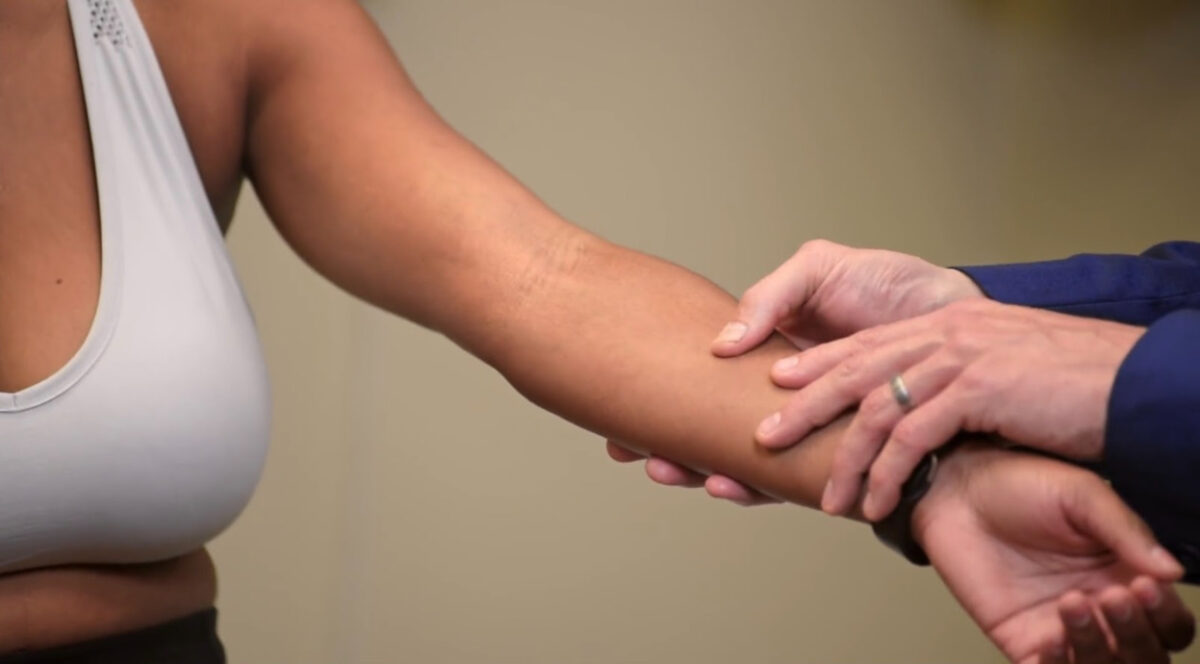
Demonstration of Nikolsky sign
Image by Lecturio.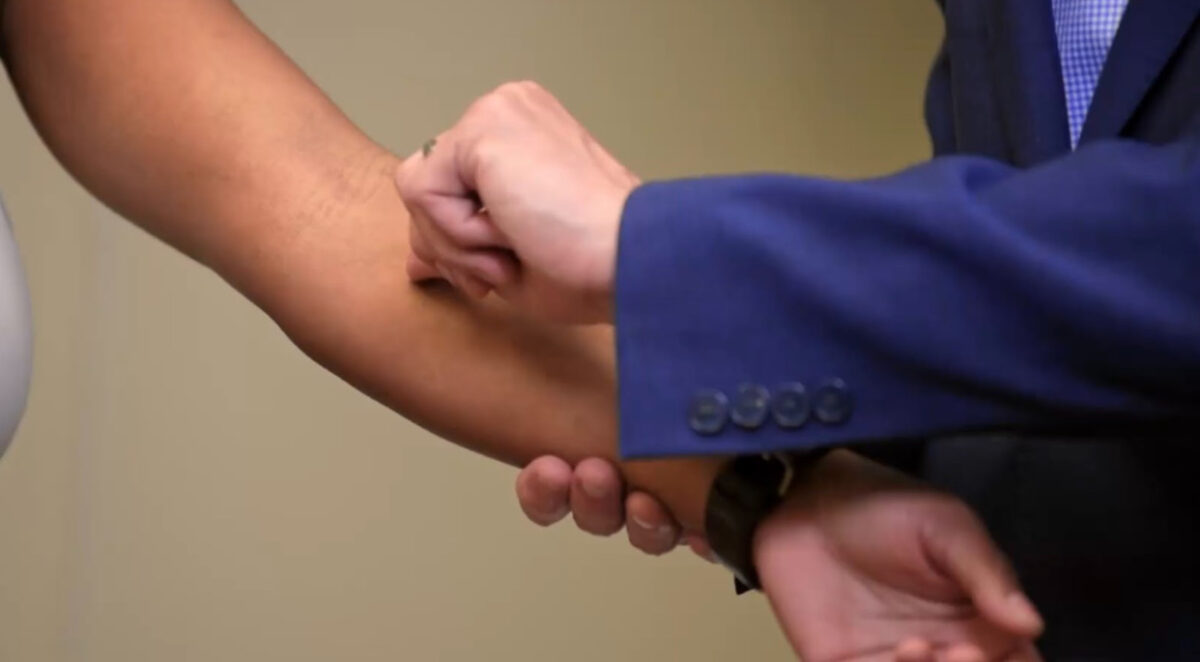
Demonstration of dermographism
Image by Lecturio.Evaluate the hair carefully, looking for any changes from the individual’s baseline.

Image showing the pattern of androgenic alopecia in males
Image by Lecturio.
Image showing the pattern of androgenic alopecia in females
Image by Lecturio.
Imaging showing the circular configuration of alopecia areata
Image by Lecturio.
Telogen effluvium:
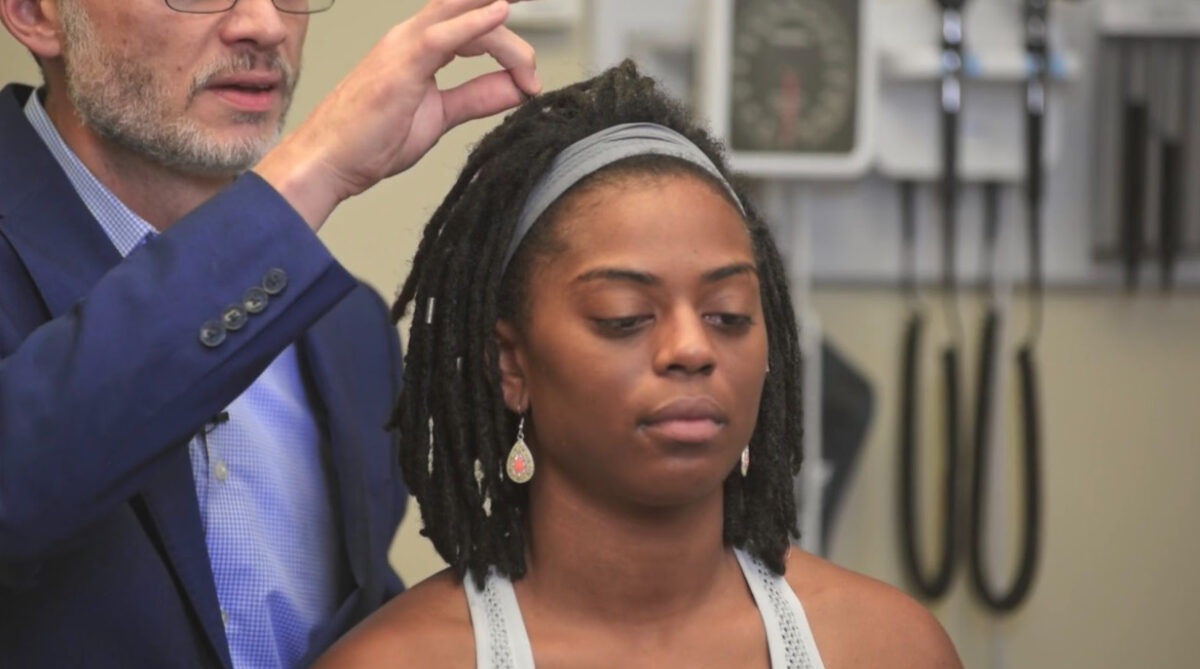
Demonstration of hair-pull test
Image by Lecturio.| Disease | Description |
|---|---|
| Alopecia areata Alopecia Areata Loss of scalp and body hair involving microscopically inflammatory patchy areas. Alopecia |
|
| Androgenetic alopecia Alopecia Alopecia is the loss of hair in areas anywhere on the body where hair normally grows. Alopecia may be defined as scarring or non-scarring, localized or diffuse, congenital or acquired, reversible or permanent, or confined to the scalp or universal; however, alopecia is usually classified using the 1st 3 factors. Alopecia |
|
| Telogen effluvium Telogen Effluvium Alopecia |
|
Inspect and palpate the nails carefully, looking for any changes.
| Clinical findings | Description | Possible underlying etiology |
|---|---|---|
| Clubbing Clubbing Cardiovascular Examination | Loss of angle between the nail fold and nail plate |
|
| Onycholysis Onycholysis Separation of nail plate from the underlying nail bed. It can be a sign of skin disease, infection (such as onychomycosis) or tissue injury. Psoriasis | Distal nail separation |
|
| Nail pitting |
|
|
| Koilonychia Koilonychia Iron Deficiency Anemia | Spoon-shaped depression | Iron Iron A metallic element with atomic symbol fe, atomic number 26, and atomic weight 55. 85. It is an essential constituent of hemoglobins; cytochromes; and iron-binding proteins. It plays a role in cellular redox reactions and in the transport of oxygen. Trace Elements deficiency anemia Anemia Anemia is a condition in which individuals have low Hb levels, which can arise from various causes. Anemia is accompanied by a reduced number of RBCs and may manifest with fatigue, shortness of breath, pallor, and weakness. Subtypes are classified by the size of RBCs, chronicity, and etiology. Anemia: Overview and Types |
| Mees lines Mees Lines Metal Poisoning (Lead, Arsenic, Iron) | White streaks |
|
| Brittle nails | Hypothyroidism Hypothyroidism Hypothyroidism is a condition characterized by a deficiency of thyroid hormones. Iodine deficiency is the most common cause worldwide, but Hashimoto’s disease (autoimmune thyroiditis) is the leading cause in non-iodine-deficient regions. Hypothyroidism | |
| Yellow nail syndrome |
|
|
| Terry nails | Proximal red/brown band on the nail plate |
|
| Half-and-half nails | Kidney disease | |
| Muehrcke lines | Double white lines | Hypoalbuminemia Hypoalbuminemia A condition in which albumin level in blood (serum albumin) is below the normal range. Hypoalbuminemia may be due to decreased hepatic albumin synthesis, increased albumin catabolism, altered albumin distribution, or albumin loss through the urine (albuminuria). Nephrotic Syndrome in Children |
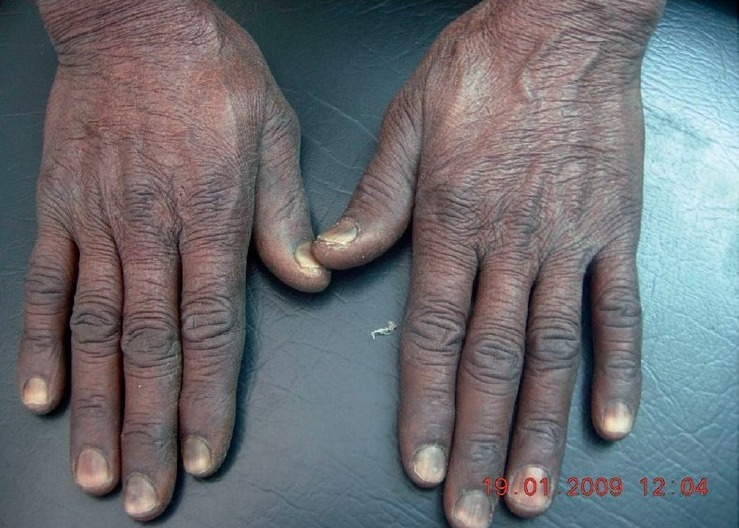
Half-and-half nails seen in kidney disease
Image: “Hyperpigmentation involving hands and all 10 finger-nails; involving proximal half to two-third of the nail plates” by Koley S., Choudhary S., Salodkar A. License: CC BY-NC-SA 4.0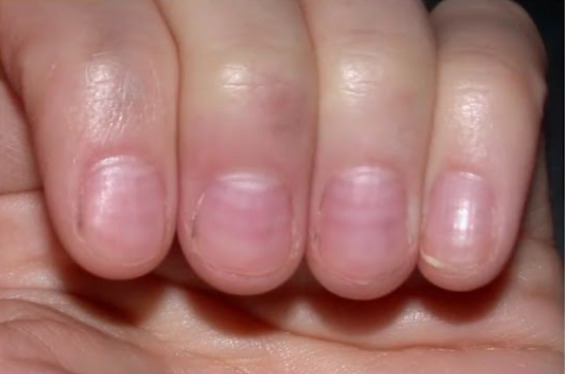
Muehrcke lines seen in hypoalbuminemia
Image: “Chemotherapy-induced Muehrcke’s lines on a 28 year old female” by Lyrl. License: Public Domain| Psoriasis Psoriasis Psoriasis is a common T-cell-mediated inflammatory skin condition. The etiology is unknown, but is thought to be due to genetic inheritance and environmental triggers. There are 4 major subtypes, with the most common form being chronic plaque psoriasis. Psoriasis | Atopic dermatitis Dermatitis Any inflammation of the skin. Atopic Dermatitis (Eczema) | Acne vulgaris Acne vulgaris Acne vulgaris, also known as acne, is a common disorder of the pilosebaceous units in adolescents and young adults. The condition occurs due to follicular hyperkeratinization, excess sebum production, follicular colonization by Cutibacterium acnes, and inflammation. Acne Vulgaris | Fungal infections Infections Invasion of the host organism by microorganisms or their toxins or by parasites that can cause pathological conditions or diseases. Chronic Granulomatous Disease | |
|---|---|---|---|---|
| Appearance |
|
|
|
|
| Distribution | Symmetrical, extensor surfaces | Flexor surfaces | Face, neck Neck The part of a human or animal body connecting the head to the rest of the body. Peritonsillar Abscess, chest, and back |
|
| Associated findings | Auspitz sign Auspitz Sign Psoriasis: pinpoint bleeding with removal of scale | History of atopy Atopy Atopic Dermatitis (Eczema) ( asthma Asthma Asthma is a chronic inflammatory respiratory condition characterized by bronchial hyperresponsiveness and airflow obstruction. The disease is believed to result from the complex interaction of host and environmental factors that increase disease predisposition, with inflammation causing symptoms and structural changes. Patients typically present with wheezing, cough, and dyspnea. Asthma and seasonal allergies Allergies A medical specialty concerned with the hypersensitivity of the individual to foreign substances and protection from the resultant infection or disorder. Selective IgA Deficiency) | Scarring Scarring Inflammation/ hyperpigmentation Hyperpigmentation Excessive pigmentation of the skin, usually as a result of increased epidermal or dermal melanin pigmentation, hypermelanosis. Hyperpigmentation can be localized or generalized. The condition may arise from exposure to light, chemicals or other substances, or from a primary metabolic imbalance. Malassezia Fungi | Confirmed by KOH prep KOH prep Dermatophytes/Tinea Infections |